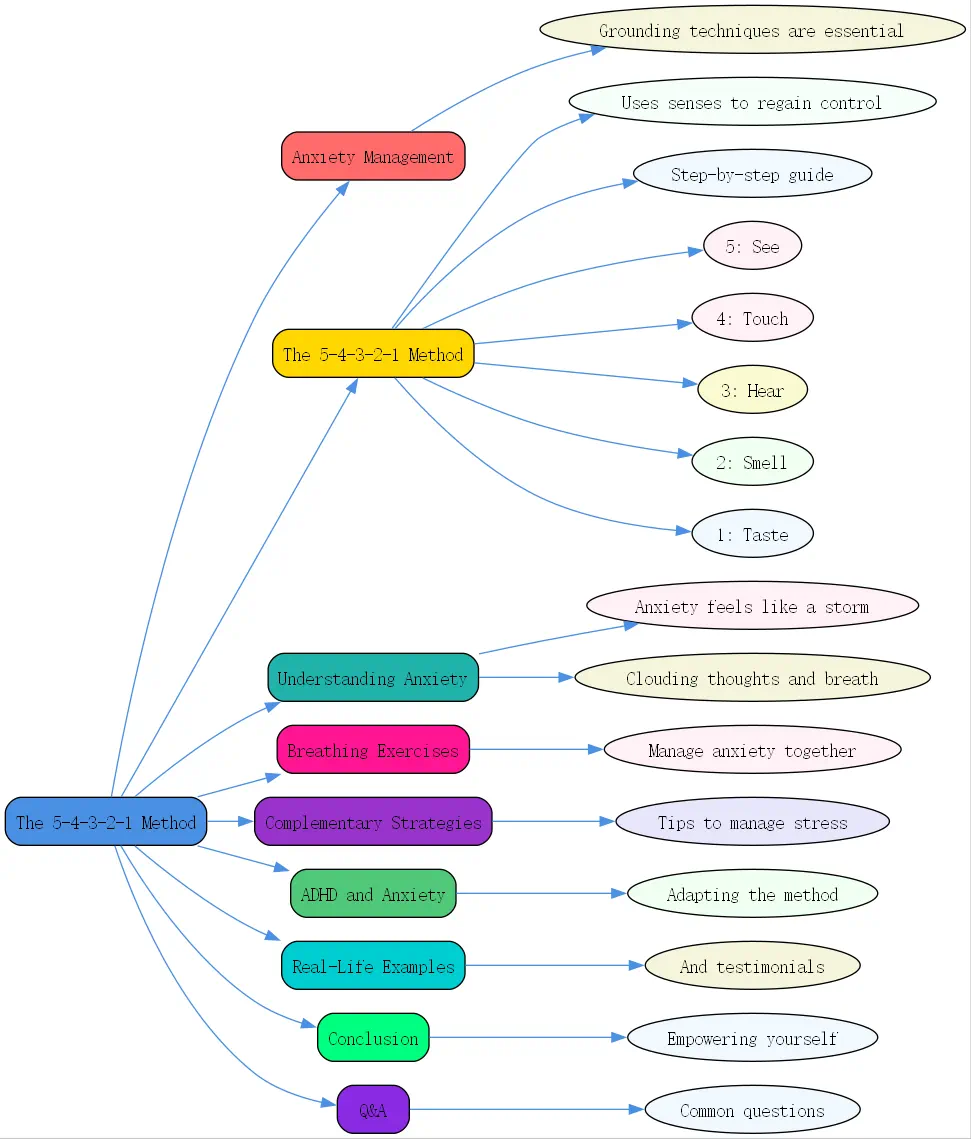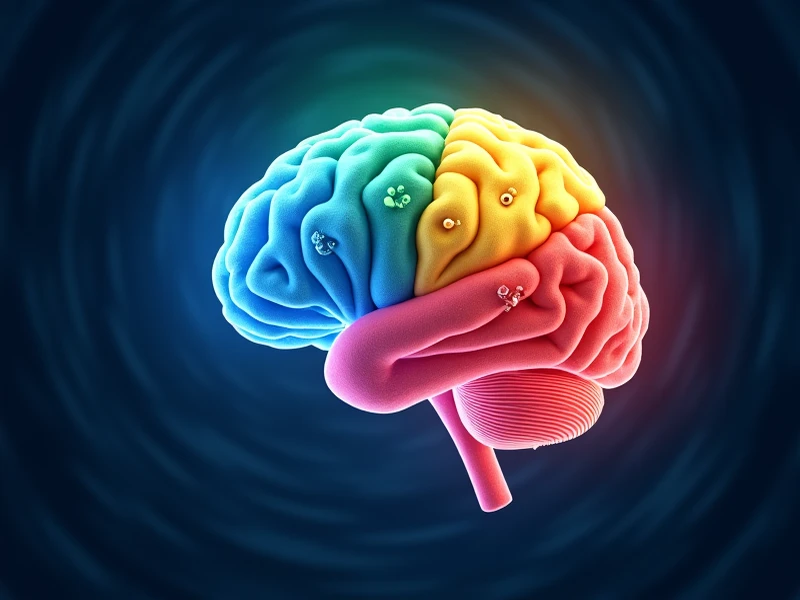The 5-4-3-2-1 Method: A Grounding Exercise to Manage Anxiety


Anxiety can feel like a sudden storm, clouding your thoughts and making it hard to catch your breath. When your mind races or panic starts to set in, having a simple, effective tool can make all the difference. Grounding techniques pull you out of the whirlpool of anxious thoughts and anchor you firmly in the present moment. One of the most accessible and powerful tools is the 5-4-3-2-1 method, a grounding exercise to manage anxiety that uses your senses to regain control.
Understanding Anxiety and the Need for Grounding Techniques
Defining Anxiety and its Impact on Daily Life
Anxiety is more than just occasional worry; it’s a persistent feeling of unease, fear, or apprehension that can significantly interfere with daily activities. It can manifest physically (racing heart, shortness of breath, trembling), emotionally (irritability, restlessness, dread), and cognitively (difficulty concentrating, catastrophic thinking). For many, anxiety can feel overwhelming, making even simple tasks seem insurmountable and hijacking their ability to respond calmly to situations. This emotional overwhelm requires practical strategies for immediate relief.

The Importance of Grounding Exercises for Emotional Regulation
Emotional regulation, the ability to understand and manage emotional responses, is crucial for navigating life’s challenges. When anxiety spikes, this ability can falter. Grounding exercises act like an emergency brake for an overactive mind. They work by shifting focus away from distressing thoughts or intense emotions and onto the physical world, using sensory input to tether you to the present. This process helps interrupt the anxiety cycle, providing the mental space needed to calm down and think more clearly. Techniques like these are vital, especially when emotions feel consuming.
Why the 5-4-3-2-1 Method is Effective
The 5-4-3-2-1 method is particularly effective because it systematically engages multiple senses. This sensory engagement forces your brain to redirect its focus from internal turmoil (worries, fears) to external, neutral stimuli. It doesn’t require any special equipment, can be done anywhere, anytime, and is easy to remember even when feeling distressed. By deliberately noticing the details of your surroundings, you create distance from overwhelming feelings, much like observing thoughts instead of being swept away by them ??a core principle of mindfulness.
The 5-4-3-2-1 Method: A Step-by-Step Guide
When anxiety starts to build, find a comfortable spot if possible (though this technique can be done anywhere) and slowly guide yourself through these steps. Take your time with each one, fully engaging the specified sense.
Step 1: Acknowledge 5 Things You Can See
Look around you and intentionally notice five distinct objects. Don’t just glance; truly see them. Name them silently or aloud: “”I see the blue pen. I see the patterned rug. I see the light reflecting off the window. I see the crack in the ceiling. I see my fingernail.”” Pay attention to details like color, shape, texture, or light. This visual focus begins pulling your attention outward.
Step 2: Acknowledge 4 Things You Can Touch
Now, bring your awareness to your sense of touch. Identify four things you can physically feel. This could be the texture of your clothing against your skin, the smooth surface of a table, the warmth of a mug, or the feeling of your feet grounded on the floor. Engage with the sensation: “”I feel the soft fabric of my sweater. I feel the cool metal of the chair arm. I feel my hair brushing my cheek. I feel the weight of my phone in my hand.””
Step 3: Acknowledge 3 Things You Can Hear
Listen carefully to your environment and pinpoint three distinct sounds. These sounds might be obvious or subtle. Tune in: “”I hear the hum of the computer. I hear distant traffic. I hear my own breathing.”” Even seemingly silent environments have sounds if you listen closely. Acknowledging these sounds further anchors you in the immediate present, away from internal noise.
Step 4: Acknowledge 2 Things You Can Smell
Engage your sense of smell. What are two scents you can identify? This might require a bit more focus. Perhaps it’s the faint aroma of coffee, the scent of soap on your hands, the smell of rain outside, or even just the neutral smell of the air in the room. “”I smell the disinfectant used earlier. I smell the faint scent of my laundry detergent.”” If you can’t easily identify smells, recall two of your favorite scents.
Step 5: Acknowledge 1 Thing You Can Taste
Finally, bring awareness to your sense of taste. Identify one thing you can taste right now. This could be the lingering taste of toothpaste, a sip of water, a piece of gum, or simply the natural taste inside your mouth. “”I taste the mint from my gum.”” You can also take a mindful sip of water or pop a mint to enhance this step. This final sensory input completes the grounding circuit.
Breathing Exercises to Manage Anxiety Alongside the 5-4-3-2-1 Method
While the 5-4-3-2-1 method is powerful on its own, combining it with conscious breathing enhances its calming effects. Intentional breathwork signals to your nervous system that it’s safe to relax. Incorporating `breathing exercises to manage anxiety` is a simple yet profound addition to your grounding practice.
Deep Breathing Techniques for Immediate Relief
Deep diaphragmatic breathing (belly breathing) is fundamental. Place one hand on your chest and the other on your belly. Inhale slowly and deeply through your nose, allowing your belly to rise (your chest should remain relatively still). Hold the breath for a count or two, then exhale slowly through your mouth, feeling your belly fall. Focusing on the exhale can be particularly helpful, as it activates the parasympathetic nervous system, promoting relaxation. Many find watching the “”heavy emotion come out of their body”” as they exhale is a powerful visual, releasing tension with the breath.
Box Breathing: A Simple and Effective Method
Box breathing, or square breathing, is another excellent technique often used by first responders and athletes to maintain calm under pressure. Visualize a square: 1. Inhale slowly through your nose for a count of 4. 2. Hold your breath for a count of 4. 3. Exhale slowly through your mouth for a count of 4. 4. Hold the breath out for a count of 4. Repeat this cycle several times. The rhythmic pattern provides structure and focus, making it easy to follow even when stressed.
Combining Breathing Exercises with the 5-4-3-2-1 Technique
You can integrate breathing seamlessly into the 5-4-3-2-1 method. Take a slow, deep breath between each step (e.g., after naming 5 things you see, take a breath before moving to 4 things you touch). Alternatively, practice a few rounds of deep breathing or box breathing before starting the 5-4-3-2-1 sequence to calm your system initially, or afterwards to deepen the relaxation. Experiment to find what combination works best for you.

Tips to Manage Anxiety and Stress: Complementary Strategies
While grounding techniques offer in-the-moment relief, incorporating broader strategies provides long-term resilience. Here are some effective `tips to manage anxiety and stress`:
Mindfulness and Meditation for Long-Term Anxiety Reduction
Regular mindfulness practice trains your brain to stay present and observe thoughts and feelings without judgment. This builds the “”muscle”” needed to handle anxiety when it arises. Techniques can range from formal sitting meditation using apps like Headspace or Calm, to informal practices like mindful walking or eating. Research consistently shows mindfulness helps manage anxiety, depression, and even symptoms associated with ADHD by fostering emotional awareness and reducing reactivity. As BrainTalking experts often emphasize, mindfulness is about paying attention to the now without getting caught up in judgment.
Physical Activity and Exercise as Stress Relievers
Movement is a powerful antidote to stress and anxiety. Exercise releases endorphins, improves mood, reduces muscle tension, and helps regulate sleep ??all crucial for managing anxiety. Find an activity you enjoy, whether it’s brisk walking, running, dancing, yoga, or team sports. Even short bursts of activity throughout the day can make a significant difference in your stress levels and overall well-being.
Creating a Supportive Environment: Social Connections and Communication
Feeling connected to others is vital for mental health. Share your feelings with trusted friends, family members, or a therapist. Talking about your anxiety can lessen its power and provide comfort and perspective. Building a supportive network ensures you have people to lean on during challenging times. Open communication helps foster understanding and reduces feelings of isolation that often accompany anxiety.
How to Manage ADHD and Anxiety: Adapting the 5-4-3-2-1 Method
Anxiety and Attention-Deficit/Hyperactivity Disorder (ADHD) often occur together. Understanding this link is key when learning `how to manage adhd and anxiety` effectively. The emotional regulation challenges common in ADHD can exacerbate anxiety, making grounding techniques like the 5-4-3-2-1 method particularly beneficial, though sometimes requiring slight adaptations.
Understanding the Link Between ADHD and Anxiety
Individuals with ADHD often experience difficulties with executive functions, including emotional regulation. This can mean feeling emotions very intensely and struggling to manage reactions, similar to the challenges described in the reference text regarding teens with ADHD. This emotional intensity can easily trigger or heighten anxiety. Furthermore, the challenges associated with ADHD symptoms (e.g., difficulty focusing, impulsivity, restlessness) can themselves be sources of stress and anxiety. Therefore, tools that promote self-awareness and calm are essential.
Modifying the 5-4-3-2-1 Method for ADHD Symptoms
For someone with ADHD who might struggle with focus or restlessness, modifying the 5-4-3-2-1 method can improve its effectiveness:
- Simplify: If five items feel overwhelming, start with 3-2-1. Focus on quality over quantity.
- Add Movement: Incorporate gentle movement, like tapping fingers for touch or shifting gaze deliberately for sight.
- Use Prompts: Use verbal or written prompts if needed to stay on track through the steps.
- Sensory Focus: Lean into the senses that are most grounding for the individual ??perhaps touch or sound are more anchoring than sight.
The goal is to make the technique accessible and helpful, adapting it to individual needs and challenges posed by ADHD symptoms like distractibility or restlessness.
Utilizing Mindfulness Apps and Tools for ADHD and Anxiety
Technology can be a valuable ally. Mindfulness apps often offer guided grounding exercises, meditations specifically for anxiety, and even body scan practices that align well with the principles of the 5-4-3-2-1 method. Timers and reminders within apps can help establish a consistent practice routine, which is often beneficial for individuals managing ADHD. Tools like fidget toys can also sometimes be incorporated into the “”touch”” aspect of the 5-4-3-2-1 method for those who find tactile input calming.
Real-Life Examples and Testimonials
Hearing how others use these techniques can be inspiring and provide practical ideas. Many people have found the 5-4-3-2-1 method, a grounding exercise to manage anxiety, to be a lifeline during stressful moments.
Stories of Individuals Benefiting from the 5-4-3-2-1 Method
Consider Sarah, a student who experiences intense anxiety before exams. She uses the 5-4-3-2-1 method while sitting at her desk, focusing on the grain of the wood, the feel of her pen, the distant sound of the hallway, the smell of old paper, and the taste of water from her bottle. This helps her center herself and reduce panic. Or think of Mark, who feels overwhelmed in crowded spaces. He steps aside and quickly runs through the steps, noticing architectural details, the feel of his keys in his pocket, distinct conversations, food smells, and the lingering taste of coffee, allowing him to navigate the situation calmly.
Incorporating Music and Mantras for Enhanced Mindfulness
As highlighted in mindfulness practices for teens, music and mantras can be powerful additions. Creating a calming playlist to listen to after a grounding exercise can extend the feeling of peace. Similarly, developing a personal mantra ??a short, positive statement like “”I am calm and present”” or “”This feeling will pass”” ??can be repeated silently during or after the 5-4-3-2-1 exercise. Repeating a mantra provides an additional anchor for the mind, reinforcing a sense of control and self-compassion.
The Importance of Consistency and Practice
Like any skill, grounding techniques become more effective with practice. It’s helpful to practice the 5-4-3-2-1 method during moments of calm, not just during high anxiety. This builds familiarity and makes it easier to access when needed most. Aiming for short, regular practice sessions ??perhaps tying it to an existing habit like brushing your teeth, as suggested for building mindfulness habits ??can make it second nature. Consistency transforms it from a mere technique into a reliable coping mechanism.
Conclusion: Empowering Yourself with Grounding Techniques
Anxiety doesn’t have to control your life. Understanding that you have tools available to manage overwhelming moments is incredibly empowering. The 5-4-3-2-1 grounding method offers a simple, practical, and effective way to regain control by anchoring you in the present moment through your senses.
Recap of the 5-4-3-2-1 Method and its Benefits
This technique guides you to identify 5 things you see, 4 things you touch, 3 things you hear, 2 things you smell, and 1 thing you taste. Its benefits lie in its simplicity, accessibility, and ability to quickly shift focus away from distressing thoughts and onto your immediate physical environment, calming the nervous system and providing mental clarity. It fosters a sense of presence and distance from overwhelming emotions.
Encouragement to Explore Various Grounding Techniques
While the 5-4-3-2-1 method is excellent, remember that different techniques resonate with different people. Explore other grounding strategies, breathing exercises, mindfulness practices like the “”movie screen”” technique mentioned in the reference text, movement, or creative expression like journaling or coloring. The goal is to build a personal toolkit of strategies that work for you. There’s no one-size-fits-all approach to managing anxiety.
Final Thoughts on Managing Anxiety and Stress Effectively
Managing anxiety and stress is an ongoing journey, not a destination. Be patient and compassionate with yourself. Incorporating grounding techniques like the 5-4-3-2-1 method, alongside complementary strategies such as breathing exercises, mindfulness, physical activity, and seeking support, provides a robust framework for navigating challenges. With practice and consistency, you can learn to effectively manage anxiety and live a calmer, more present life. Remember to explore resources and strategies, like those offered by BrainTalking, to support your mental well-being journey.
Q&A Section
Q: How often should I practice the 5-4-3-2-1 grounding method for it to be effective?




